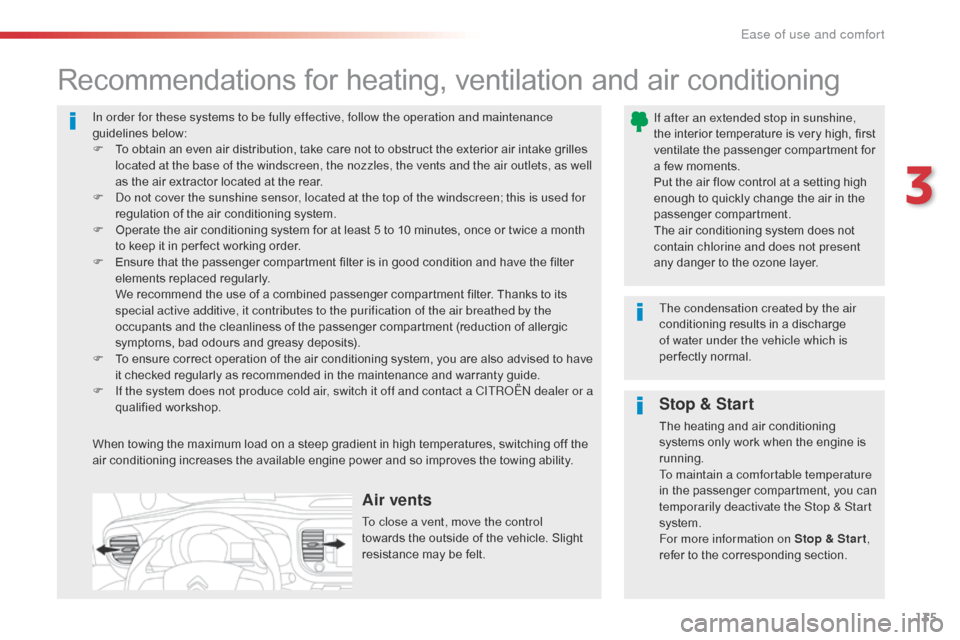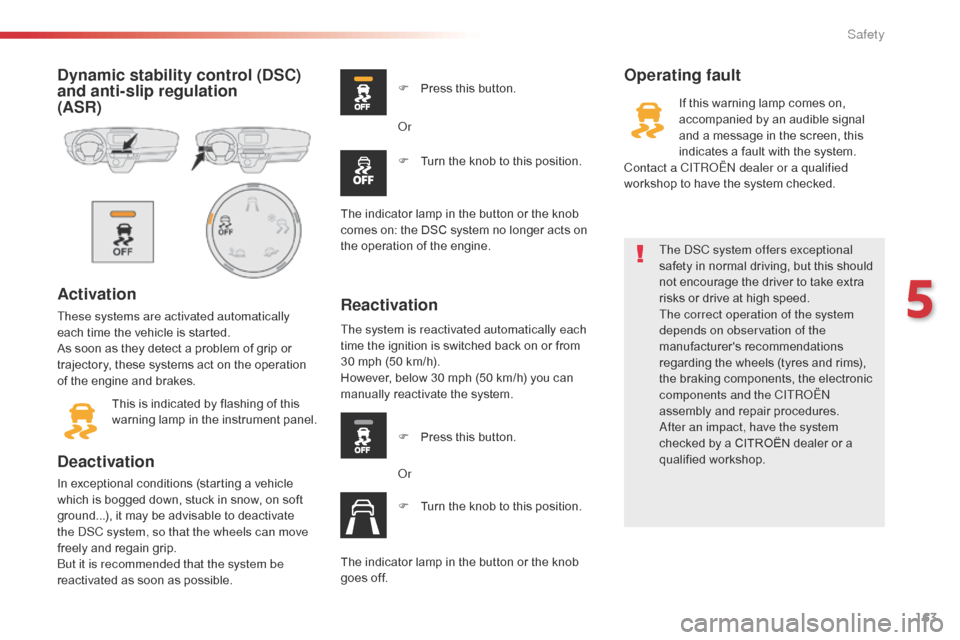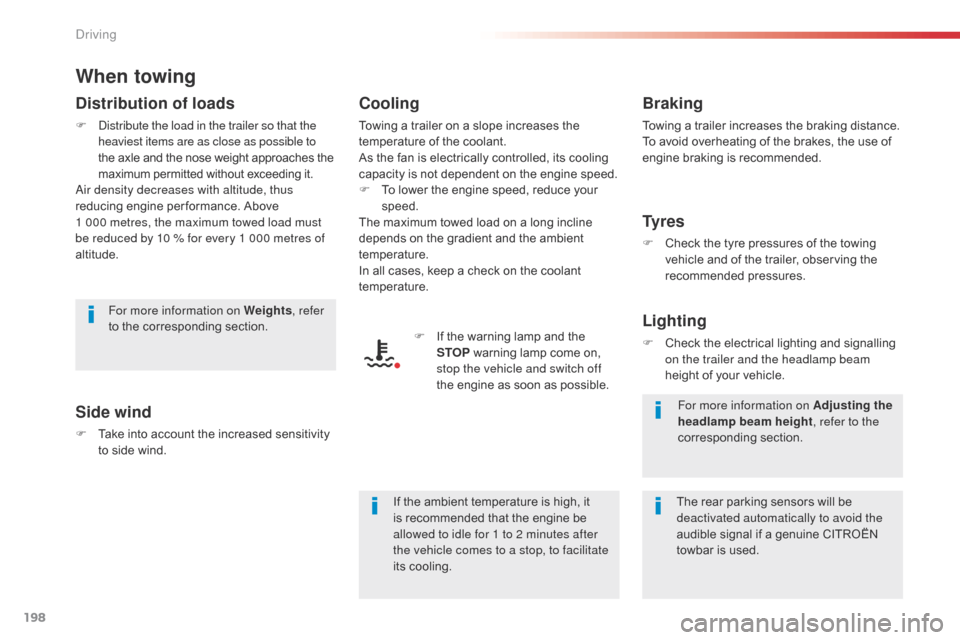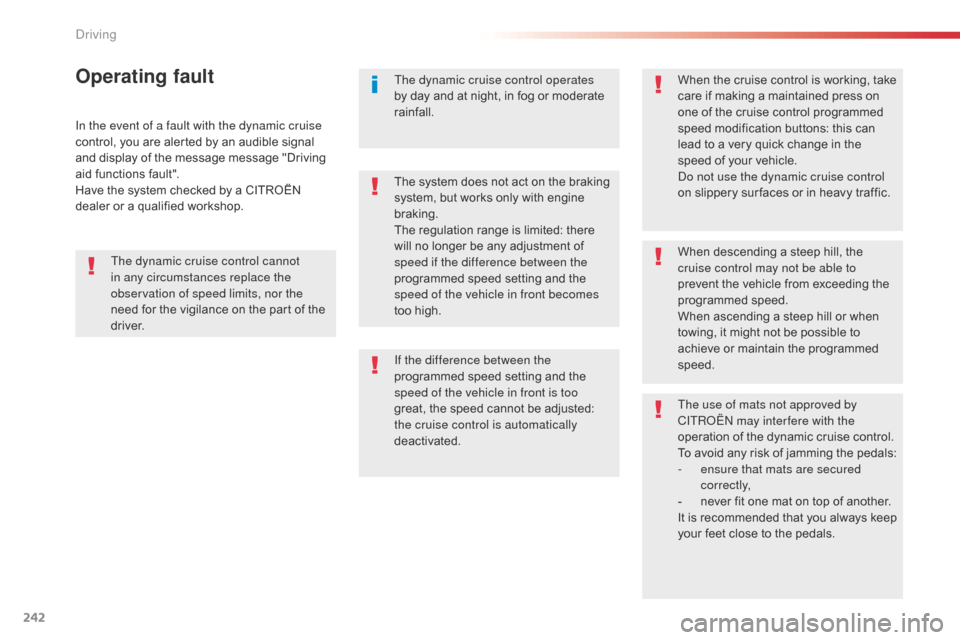check engine Citroen JUMPY 2016 2.G User Guide
[x] Cancel search | Manufacturer: CITROEN, Model Year: 2016, Model line: JUMPY, Model: Citroen JUMPY 2016 2.GPages: 595, PDF Size: 12.47 MB
Page 39 of 595

37
Jumpy _en_Chap01_instruments-de-bord_ed01-2016
Starting prevented
Every time the ignition is switched on, these
warning lamps come on, accompanied by an
audible signal and the display of the message
"Emissions fault: Starting prevented".You have exceeded the authorised
driving limit: the starting prevention
system inhibits engine starting.
To be able to start the engine, you must call on
a CITROËN dealer or a qualified workshop.
In the event of a fault with the SCR emissions control system
A system that prevents engine starting is activated automatically from 650 miles (1 100 km) after confirmation of a fault with the SCR emissions
control system. Have the system checked by a CITROËN dealer or a qualified workshop as soon as possible.
If it is a temporary fault, the alert
disappears during the next journey,
after self-diagnosis of the SCR system.
In the event of the detection
of a fault
These warning lamps come on, accompanied
by an audible signal and the display of the
message "Emissions fault".
The alert is triggered when driving when the
fault is detected for the first time, then when
switching on the ignition for subsequent
journeys, while the fault persists.
During an authorised driving phase (between
650 miles and 0 miles) (1 100 km and 0 km)
If a fault with the SCR system is confirmed (after
30 miles (50 km) covered with the permanent
display of the message signalling a fault), these
warning lamps come on, accompanied by an
audible signal and the display of a message
(e.g.: "Emissions fault: Starting prevented in
150
miles") indicating the remaining range
expressed in miles or kilometres.
If your vehicle has an LCD instrument panel,
"NO START IN" is displayed.
While driving, the message is displayed every
30 seconds while the fault with the SCR system
persists.
The alert is repeated when switching on the ignition.
You should go to a CITROËN dealer or a qualified
workshop as soon as possible.
Other wise, you will not be able to restart your
engine.
If your vehicle has an LCD instrument panel,
"NO START IN" is displayed.
1
Instruments
Page 86 of 595

84
Jumpy _en_Chap02_ouvertures_ed01-2016
General
recommendations
The doors must only be operated when
the vehicle is stationary.
For your safety and for that of your
passengers, as well as for correct
operation of the doors, you are strongly
advised not to drive with a door open.
Always check that it is safe to operate
the door and in particular, be sure not to
leave children or animals near the door
controls without supervision.
The audible warning, illumination of
the "door open" warning lamp and the
message in the multifunction screen
are there to remind you. Contact
a CITROËN dealer or a qualified
workshop to deactivate these warnings.
Lock your vehicle when using an
automatic car wash.Before any opening or closing and
during any movement of the doors,
ensure that no person, animal or object
is protruding through the window
frame or might prevent the intended
manoeuvre, either inside or outside the
vehicle.
If this advice is not followed, injuries or
damage may occur if a person or an
object is trapped or caught.
Electric closing and opening of the
doors is not possible above 2 mph
(3
km/h):
-
I
f you set off with the door(s) open,
you must slow down to below
20
mph (30 km/h) in order to close
the door(s).
-
A
ny attempt to open a door
electrically using the interior handle
while driving, results in only being
possible to open the door manually.
-
T
his situation is accompanied by
the audible warning, illumination of
the "door open" warning lamp and
the message in the multifunction
screen. To release the door and
be able to operate it again, it is
necessary to stop the vehicle.
Manual or electric sliding side door(s)
The electric controls are inhibited in the
event of an impact. Manual opening and
closing remain possible.
While starting the engine, the
movement of a door is interrupted and
restored once the engine is running.
Depending on the engine, in Stop
mode of Stop & Start, if the door
is closed and you initiate opening
of the door, the door opens
partially and stops. When the
engine changes automatically to
Start mode, the door continues its
movement.
Access
Page 137 of 595

135
Jumpy _en_Chap03_ergonomie-et-confort_ed01-2016
In order for these systems to be fully effective, follow the operation and maintenance
guidelines below:
F
T
o obtain an even air distribution, take care not to obstruct the exterior air intake grilles
located at the base of the windscreen, the nozzles, the vents and the air outlets, as well
as the air extractor located at the rear.
F
D
o not cover the sunshine sensor, located at the top of the windscreen; this is used for
regulation of the air conditioning system.
F
O
perate the air conditioning system for at least 5 to 10 minutes, once or twice a month
to keep it in per fect working order.
F
E
nsure that the passenger compartment filter is in good condition and have the filter
elements replaced regularly.
W
e recommend the use of a combined passenger compartment filter. Thanks to its
special active additive, it contributes to the purification of the air breathed by the
occupants and the cleanliness of the passenger compartment (reduction of allergic
symptoms, bad odours and greasy deposits).
F
T
o ensure correct operation of the air conditioning system, you are also advised to have
it checked regularly as recommended in the maintenance and warranty guide.
F
I
f the system does not produce cold air, switch it off and contact a CITROËN dealer or a
qualified workshop.
Recommendations for heating, ventilation and air conditioning
If after an extended stop in sunshine,
the interior temperature is very high, first
ventilate the passenger compartment for
a few moments.
Put the air flow control at a setting high
enough to quickly change the air in the
passenger compartment.
The air conditioning system does not
contain chlorine and does not present
any danger to the ozone layer.
The condensation created by the air
conditioning results in a discharge
of water under the vehicle which is
per fectly normal.
When towing the maximum load on a steep gradient in high temperatures, switching off the
air conditioning increases the available engine power and so improves the towing ability.
Stop & Start
The heating and air conditioning
systems only work when the engine is
running.
To maintain a comfortable temperature
in the passenger compartment, you can
temporarily deactivate the Stop & Start
system.
For more information on Stop & Star t ,
refer to the corresponding section.
Air vents
To close a vent, move the control
towards the outside of the vehicle. Slight
resistance may be felt.
3
Ease of use and comfort
Page 165 of 595

163
Jumpy _en_Chap05_securite_ed01-2016
Dynamic stability control (DSC)
and anti-slip regulation
(ASR)
Activation
These systems are activated automatically
each time the vehicle is started.
As soon as they detect a problem of grip or
trajectory, these systems act on the operation
of the engine and brakes.This is indicated by flashing of this
warning lamp in the instrument panel.
Deactivation
In exceptional conditions (starting a vehicle
which is bogged down, stuck in snow, on soft
ground...), it may be advisable to deactivate
the DSC system, so that the wheels can move
freely and regain grip.
But it is recommended that the system be
reactivated as soon as possible.
Operating fault
Reactivation
F Press this button. F
T
urn the knob to this position.
Or
The indicator lamp in the button or the knob
comes on: the DSC system no longer acts on
the operation of the engine. The system is reactivated automatically each
time the ignition is switched back on or from
30
mph (50 km/h).
However, below 30 mph (50 km/h) you can
manually reactivate the system. F
P
ress this button.
Or
F
T
urn the knob to this position.
The indicator lamp in the button or the knob
goes off. The DSC system offers exceptional
safety in normal driving, but this should
not encourage the driver to take extra
risks or drive at high speed.
The correct operation of the system
depends on observation of the
manufacturer's recommendations
regarding the wheels (tyres and rims),
the braking components, the electronic
components and the CITROËN
assembly and repair procedures.
After an impact, have the system
checked by a CITROËN dealer or a
qualified workshop.If this warning lamp comes on,
accompanied by an audible signal
and a message in the screen, this
indicates a fault with the system.
Contact a CITROËN dealer or a qualified
workshop to have the system checked.
5
Safety
Page 200 of 595

198
Jumpy _en_Chap06_conduite_ed01-2016
When towing
Distribution of loads
F Distribute the load in the trailer so that the heaviest items are as close as possible to
the axle and the nose weight approaches the
maximum permitted without exceeding it.
Air density decreases with altitude, thus
reducing engine per formance. Above
1
000 metres, the maximum towed load must
be reduced by 10
% for every 1 000 metres of
altitude.
Side wind
F Take into account the increased sensitivity to side wind.
Cooling
Towing a trailer on a slope increases the
temperature of the coolant.
As the fan is electrically controlled, its cooling
capacity is not dependent on the engine speed.
F
T
o lower the engine speed, reduce your
speed.
The maximum towed load on a long incline
depends on the gradient and the ambient
temperature.
In all cases, keep a check on the coolant
temperature.
F
I
f the warning lamp and the
STOP warning lamp come on,
stop the vehicle and switch off
the engine as soon as possible.
Braking
Towing a trailer increases the braking distance.
To avoid overheating of the brakes, the use of
engine braking is recommended.
Ty r e s
F Check the tyre pressures of the towing vehicle and of the trailer, observing the
recommended pressures.
Lighting
F Check the electrical lighting and signalling on the trailer and the headlamp beam
height of your vehicle.
For more information on Weights
, refer
to the corresponding section.
The rear parking sensors will be
deactivated automatically to avoid the
audible signal if a genuine CITROËN
towbar is used.
If the ambient temperature is high, it
is recommended that the engine be
allowed to idle for 1 to 2 minutes after
the vehicle comes to a stop, to facilitate
its cooling. For more information on Adjusting the
headlamp beam height
, refer to the
corresponding section.
Driving
Page 208 of 595

206
Jumpy _en_Chap06_conduite_ed01-2016
Hill start assist
System which keeps your vehicle immobilised
temporarily (approximately 2 seconds) when
starting on a gradient, the time it takes to
move your foot from the brake pedal to the
accelerator pedal.
It only operates when:
-
t
he vehicle is completely stationary, with
your foot on the brake pedal,
-
t
he driver’s door is closed.
This hill start assist system cannot be
deactivated.
On a descending slope, with the vehicle
stationary and reverse gear engaged, the
vehicle is held momentarily when you
release the brake pedal.
On an ascending slope, with the vehicle
stationary, the vehicle is held for a momentarily
when you release the brake pedal.
Operating fault
F If your vehicle has a manual gearbox, place
the lever in the first gear position or in
neutral.
F
I
f your vehicle has an automatic gearbox,
place the selector at position D or select
manual operation M .
F
I
f your vehicle has an electronic gearbox,
place the selector at position A or M .If a fault in the system occurs, this warning
lamp comes on accompanied by a message.
Contact a CITROËN dealer or a qualified
workshop as soon as possible to have the
system checked.
Do not leave the vehicle while it is being
held in the hill start assist phase.
If you need to get out of the vehicle with
the engine running, apply the parking
brake manually then ensure that the
parking brake indicator lamp is on.
If your vehicle has an automatic
gearbox and you have to move off on
a steep slope (rising or falling) with a
loaded vehicle, press the brake pedal ,
select position D , release the parking
brake then release the brake pedal.
Driving
Page 215 of 595

213
Jumpy _en_Chap06_conduite_ed01-2016
When the ignition is on, a message
appears in the instrument panel
screen to indicate a gearbox fault.
Operating fault
In this case, the gearbox switches to back-up
mode and is locked in 3rd gear. You may feel
a substantial knock when changing from P
to R and from N to R. This will not cause any
damage to the gearbox.
Do not exceed 60 mph (100 km/h), local speed
restrictions permitting.
Have it checked by a CITROËN dealer or a
qualified workshop. You risk damaging the gearbox:
-
i
f you press the accelerator and
brake pedals at the same time
(braking or acceleration must be
done only with the right foot),
-
i
f you force the selector from
position P to another position when
the battery is flat.
To reduce fuel consumption when
stationary for long periods with the
engine running (traffic jam...), position
the selector at N and apply the parking
brake.
Stopping the vehicle
A stiff point may be noticed when
moving to position P .
If the selector is not in position P ,
when the driver's door is opened or
approximately 45 seconds after the
ignition is switched off, there is an
audible signal and a message appears.
F
R
eturn the selector to position P ;
the audible signal stops and the
message disappears.
Before switching off the engine, select
position
P then apply the parking brake to
immobilise the vehicle. In all circumstances, ensure that the
selector is in position P before leaving
your vehicle. On a steep slope with a loaded
vehicle, press the brake pedal
, select
position
P
, apply the parking brake then
release the brake pedal.
6
Driving
Page 219 of 595

217
Jumpy _en_Chap06_conduite_ed01-2016
With the ignition on, the flashing of A or
AUTO, accompanied by an audible signal and
a message, indicates a malfunction of the
gearbox.
Operating fault
Have it checked by a CITROËN dealer or a
qualified workshop.
Stopping the vehicle
Before switching off the engine, you can:
- m ove to position N to engage neutral,
or
-
l
eave the gear engaged; in this case, it will
not be possible to move the vehicle.
In both cases, you must apply the parking
brake to immobilise the vehicle.
At low speed, if reverse gear is
requested, the N
indicator flashes
and the gearbox goes into neutral
automatically. To engage reverse,
move the selector to position N , then
position
R . When immobilising the vehicle, with
the engine running, you must move the
selector to neutral N
.
Before doing anything under the bonnet
ensure that the selector is in neutral N
and that the parking brake is applied. Always press the brake pedal when
starting the engine.
In all parking situations, you must apply
the parking brake to immobilise the
vehicle.
To engage reverse gear, the vehicle must be
immobilised with your foot on the brake pedal.
Reverse
F Select position R
.
Engagement of reverse gear is accompanied
by an audible signal.
6
Driving
Page 223 of 595

221
Jumpy _en_Chap06_conduite_ed01-2016
Operating fault
Depending on your vehicle's equipment:
Have it checked by a CITROËN dealer or a
qualified workshop.
In the event of a fault in STOP mode, the
vehicle may stall.
All of the instrument panel warning lamps
come on.
Depending on version, an alert message may
also be displayed, asking you to place the gear
lever in position N and put your foot on the
brake pedal.
With the vehicle stationary, you must switch off
the ignition and then start the engine again. The Stop & Start system requires a
12
V battery with a special specification
and technology.
The warning lamp in this button
flashes and a message appears,
accompanied by an audible signal. In the event of a fault with the
system, this warning lamp flashes in
the instrument panel. All work on this type of battery must
be done by a CITROËN or a qualified
workshop.
For more information on the
12
V batter y, refer to the corresponding
section.
6
Driving
Page 244 of 595

242
Jumpy _en_Chap06_conduite_ed01-2016
In the event of a fault with the dynamic cruise
control, you are alerted by an audible signal
and display of the message message "Driving
aid functions fault".
Have the system checked by a CITROËN
dealer or a qualified workshop.
Operating faultThe dynamic cruise control operates
by day and at night, in fog or moderate
rainfall.When the cruise control is working, take
care if making a maintained press on
one of the cruise control programmed
speed modification buttons: this can
lead to a very quick change in the
speed of your vehicle.
Do not use the dynamic cruise control
on slippery sur faces or in heavy traffic.
When descending a steep hill, the
cruise control may not be able to
prevent the vehicle from exceeding the
programmed speed.
When ascending a steep hill or when
towing, it might not be possible to
achieve or maintain the programmed
speed.
The use of mats not approved by
CITROËN may inter fere with the
operation of the dynamic cruise control.
To avoid any risk of jamming the pedals:
-
e
nsure that mats are secured
c o r r e c t l y,
-
n
ever fit one mat on top of another.
It is recommended that you always keep
your feet close to the pedals.
If the difference between the
programmed speed setting and the
speed of the vehicle in front is too
great, the speed cannot be adjusted:
the cruise control is automatically
deactivated. The system does not act on the braking
system, but works only with engine
braking.
The regulation range is limited: there
will no longer be any adjustment of
speed if the difference between the
programmed speed setting and the
speed of the vehicle in front becomes
too high.
The dynamic cruise control cannot
in any circumstances replace the
observation of speed limits, nor the
need for the vigilance on the part of the
driver.
Driving